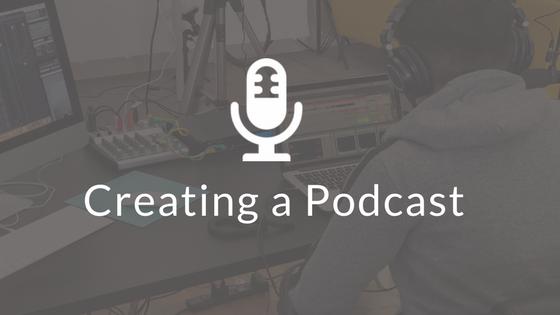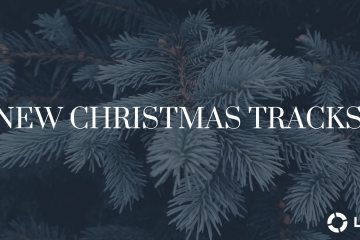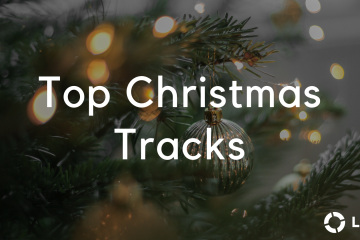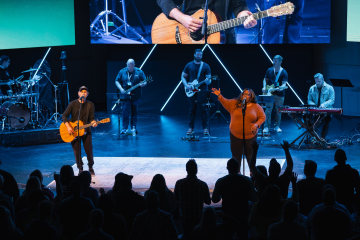Creating a Podcast

If you listen to podcasts as much as I do, you may find yourself thinking, “I bet I could do that.” Whether it’s a podcast that tells a story, discusses current events, or helps you with your business, there are tons of podcasts out there. If you have a passion for something or a topic that you are knowledgeable about, you might even be thinking of starting a podcast. But what are the tools needed to make a high-quality podcast? At Loop Community, we had this same question about a year ago. After doing a lot of research, and launching our own podcast, I mapped out the simple steps to creating a podcast so that you can share your insight with the world, too.
Content & Structure
First and foremost, content. What is your podcast about? What topics will it focus on? Before buying any equipment or tracking anything, these questions should be answered. Plan out individual episodes with different topics for each one. You don’t need to plan all of them out, but start with the first three or four to get a good start. At Loop Community, we take a topic and pair it with a friend of ours in the worship world who we interview. Having someone featured on each episode encourages community and gives a fresh perspective for our listeners. If it’s only you on the podcast every week, people may get bored. Getting good interviews brings in listeners.
The structure or layout of each episode should also be planned out. The layout of your podcast can be as simple as a discussion on a topic. However, a more complex podcast with different segments and music can be more entertaining. For example, the LC Podcast kicks off with intro music filled with synth sounds backed by a drum beat. Within that is a snippet from the interview that highlights a key point or idea. After this, we have a brief intro to the interview that is coming up. The interview is between 30-45 minutes. Then we have our community talk segment that recaps the interview. We also add a few of bonus segments for our podcast. We have featured an LC Producer, answered “Mailbag” questions (you can email podcast@loopcommunity.com with your questions), and more. The better everything is laid out, the easier it will be to schedule and put together.
Equipment & Software
You need the right equipment and software to record a podcast. Any DAW (Digital Audio Workstation) software on your computer will do. I use Ableton Live to track our episodes. I find it’s the easiest for podcast recording. DAWs like Ableton Live and Logic give you plug-ins such as an equalizer and compressor to help polish the sound after the recording is done. Whether you use Ableton, Logic, Pro Tools, or any other DAW, they really help give you a simple podcast tracking session.
In terms of hardware, you will need preferably two or more microphones (one for each person). There are a lot of microphones out there and your choice is really going to depend on your budget. Here at LC, we have a pair of Shure SM7B’s. We love these and they provide a very high-quality sound. However, there are cheaper options such as the Shure SM57 and other recording microphones. We then route our microphones to an audio interface. We use the MOTU UltraLite-mk4. It works great for controlling the audio while recording. Sidenote, it also works great with PRIME and can be connected to an iPad. You could also use a Focusrite Scarlett 2i2 or another USB audio interface. If you are just starting out and don’t have experience with audio, you could start by using a good USB microphone that hooks up to your computer. Whatever you choose, pick what works best for you and your budget.
Recording
After you have all your equipment ready and the people you need for the podcast, you are ready to go! Make sure you check the levels of the mics before recording and do a soundcheck. You also want to listen for background noise or interference to see if that is being picked up in the audio. After that, record away! I suggest watching the levels while you record, and jotting down notes of times when you may need to make edits. I am the producer of the podcast which allows me to do this while recording. If you are doing a podcast on your own or don’t have someone else who can do this, that’s okay. I routinely have to go back and listen to the whole episode anyways.
Editing and Mixing
When you have all of your audio files, it’s time to edit. When editing the files, my mindset is to polish the product so that the dialogue runs smoothly. You want the people on the podcast to sound professional. This means taking out a lot of the “um’s”, “uh’s”, or pauses in the dialogue as well as any other unnecessary sounds. Going through this process with each dialogue segment may be time-consuming, but will allow for a more polished product at the end. Another process to help polish the finished product is mixing. This includes adding a noise reducer, eq, and compression to tracks inside of your DAW.
A great tip for saving time during this process is to create a template session in your DAW. In the template I use, I have pre-made tracks with plugins already set so I can easily drop a file I have edited into its corresponding slot. I also have tracks designated for the music of the podcast with fade-in and fade-out automation already in place. After I have placed all the files in my template session and mixed then accordingly, all I have to do is piece them in order and bounce it down to create the finished product.
Post and Promote
Now that you have your finished product, you can share it with the world! At LC, we put our podcast out on iTunes through WordPress. There are a number of steps to this process, so click here for instructions on getting your podcast on Apple Podcasts. After your podcast is accepted and your first episode is on iTunes, the following episodes simply need to be added to your WordPress page. After a few hours Apple will recognize the new episode and post it on your iTunes podcast page. You’ll then want people to listen to your podcast! We promote our podcast on our social media outlets to notify listeners of a new episode. Tell your friends, post on social media, and post wherever you think people may listen. Always remind them to subscribe!
I hope this guide was helpful to those wanting to start a podcast! Be consistent with posting episodes, create good content, and have fun.
Listen & Subscribe to the Loop Community Podcast
Jonathan Magalit
Jonathan graduated from Elmhurst College with a degree in Music Business and a minor in Music Production. Jonathan is a worship leader and an aspiring producer/composer who hopes to one day write music for film and video games.



0 Comments